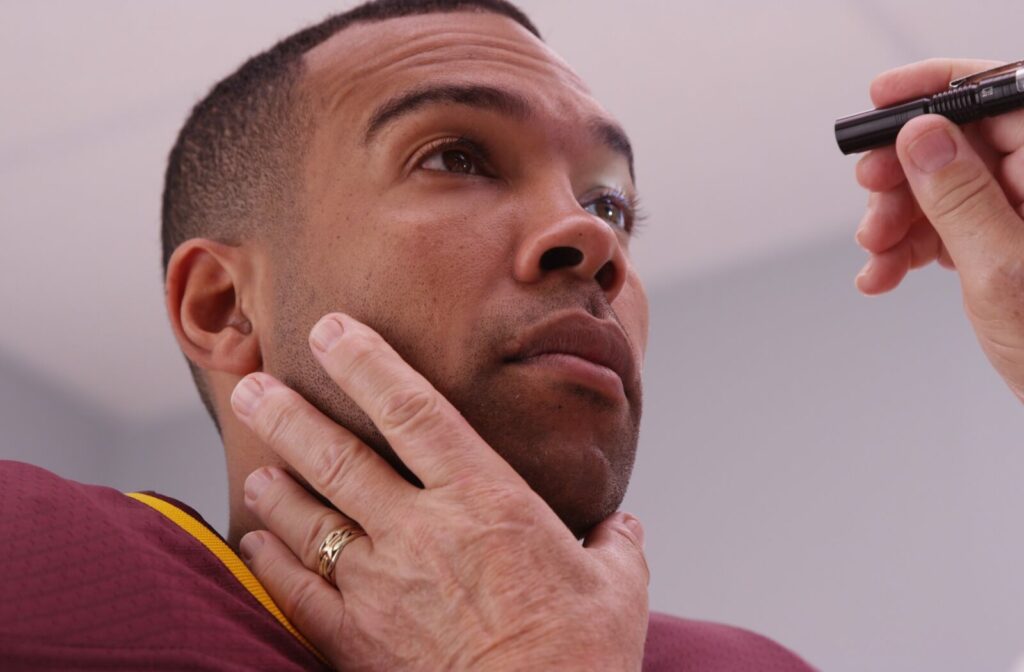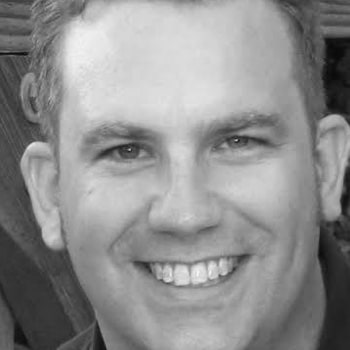After a bump or blow to the head, it’s natural to worry about a concussion. Fortunately, because the visual system is closely connected to brain function, the eyes can offer us insight into whether a person is concussed. Understanding the nature of vision problems after a concussion can help you take the right next steps for your or your loved ones’ health.
You can check for a concussion in the eyes by observing for visible signs like unequal pupils and performing simple tracking tests, though these observations should be followed by a professional evaluation.
What Concussed Eyes Look Like
Vision symptoms are common after a head injury. Some signs may be noticeable to an observer, while some you can feel yourself.
Visible Signs in the Eyes
- One pupil larger than the other
- Eyes that don’t move together
- Difficulty tracking objects or people
- A droopy eyelid
- Sudden jerking eye movements
Symptoms a Person May Feel
- Blurry or double vision
- Sensitivity to light
- Trouble with depth perception
- Difficulty focusing or reading
Simple At-Home Eye Checks For a Possible Concussion
You can perform some simple checks to gather information after a head injury. These observations do not replace a medical evaluation, but they can provide helpful details to share with a healthcare professional.
The Finger Follow Test
This is a common way to check for issues with eye tracking. It helps determine whether a person’s eyes can follow a moving object smoothly.
- Have the person you’re testing sit or stand still and look straight ahead.
- Hold your finger about 18 inches away from their face.
- Move your finger slowly up, down, left, & right.
- Ask them to follow your finger using only their eyes, not moving their head.
- Watch to see if their eyes move together or if one lags or jerks.
The Flashlight Test
A flashlight can help you observe how the pupils react to light. A phone often works for this, but try to use it on a lower brightness setting for comfort.
- Find a room with dim lighting.
- Ask the person to look straight ahead.
- Note the size of their pupils before you use the light.
- Shine the light toward one eye from the side—not directly into it.
- Watch to see if the pupil gets smaller quickly and check that the opposite pupil also gets smaller.
- Repeat on the other eye. A typical response is for both pupils to constrict equally & quickly.
Professional Tests That Assess Vision & Brain Function
Healthcare professionals use specific tools to assess how a concussion has affected the brain. Many of these tests include a vision component. Your eyes can offer a direct window into brain function.
The King-Devick Test
This is a quick sideline test used in sports, where baseline visual performance is key. Athletes can establish this baseline through comprehensive sports vision training. The test involves reading single-digit numbers from test cards as fast as possible. The time it takes is compared to a pre-season baseline time, and a slower time may point to a concussion.
Sports Concussion Assessment Tool 5 (SCAT5)
This is a detailed tool used for people 13 years and older. It evaluates many abilities, including symptoms, balance, and cognition. It can help a professional get a full picture of an injury.
Computerized Neurocognitive Tests
These tests are like video games that measure brain function. They assess factors like visual memory, reaction time, and the brain’s processing speed. Results are often compared to a baseline test taken before an injury.

The Link Between Vision & Concussion Recovery
Your brain dedicates a large amount of its resources to processing what you see. After a concussion, the communication pathway between your eyes and your brain can be disrupted. This disruption is why symptoms like headaches, dizziness, and focus problems can linger and make it hard to return to daily activities.
How Vision Therapy Helps
Because of the close relationship between vision and brain function, targeted therapy can be very effective. Vision therapy for neuro-rehab is an active program designed to help retrain and improve the connection between the brain and the eyes. It may involve specific exercises to help with eye teaming, focusing, and tracking abilities.
Vision therapy can be a helpful part of the recovery process after a concussion, addressing the root cause of many persistent symptoms.
When to Get Medical Attention
It’s important to seek medical help after any significant head injury, as some situations can be considered medical emergencies. You should go to an emergency room if you or someone else notices any of these signs.
- A headache that gets worse and won’t go away
- Weakness or numbness
- Repeated nausea or vomiting
- Slurred speech
- Seizures or convulsions
- Unusual behaviour, confusion, or agitation
- Loss of consciousness—even for a short time
Even without these serious signs, any suspected concussion should be evaluated by a healthcare professional. A thorough checkup can help manage the injury properly. It also sets a path for a safe return to school, work, or sports.
Why Visit an Eye Doctor in Milton After a Head Injury
Even if you don’t need emergency care, a comprehensive eye exam is always a good precautionary step.
At Milton Vision & Sports Vision Training Centre, we provide personalized attention for your whole family. We can help identify and manage vision-related concussion symptoms, including providing unique sports vision solution training. Contact us to schedule an appointment and let us help you on your road to recovery.



